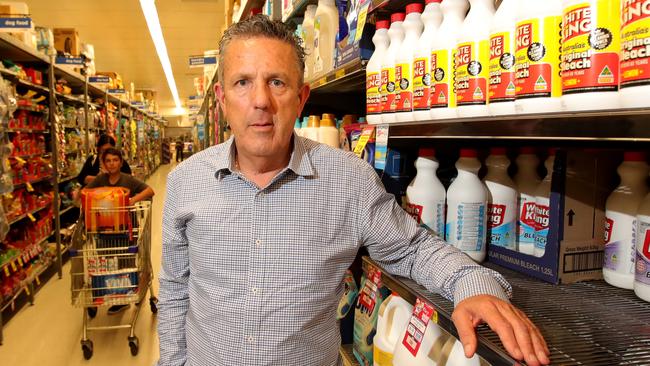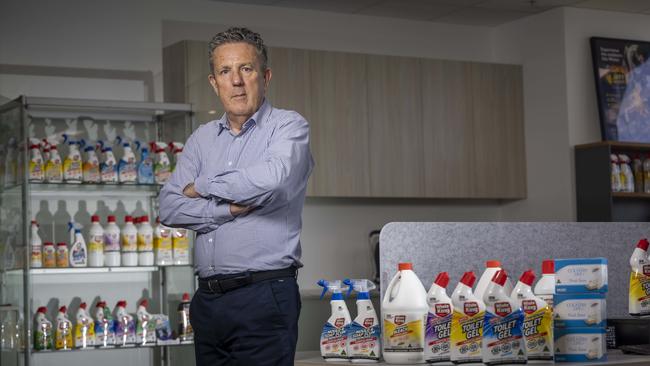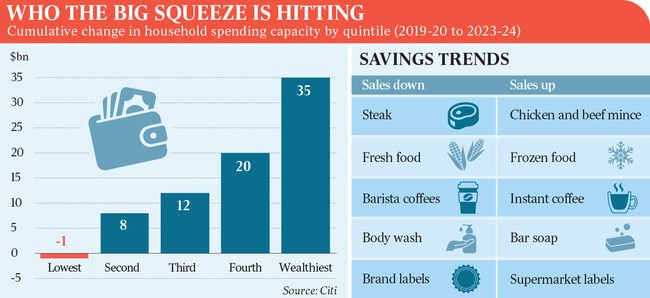Poorer households are facing squeezed shopping budgets that will see them with $1bn less to spend at the shops by 2024
Consumers are switching body wash for soap bars and turning to other cheap ‘life hacks’ to stretch the dollar further, as they face another bleak year of belt tightening.

The nation’s poorest households will see their capacity to spend at the shops slashed by $1bn between 2020 and 2024 as the squeeze on their budgets and shopping firepower is eroded by rising rents, utility bills, fuel and other soaring cost of living expenses.
According to a latest report on the state of the consumer, Australia’s bottom 20 per cent of households in terms of income have not seen their spending power rise in three years and are now facing another bleak year of belt tightening as their disposable income shrinks.
The sharp slowdown in spending by poorer households will have wider ramifications for the Australian economy and the $400bn retail sector too — a crucial pillar of the national economy and major source of employment — with retail spending tipped to only grow by $14bn in 2024, a marked slowdown from the estimated $25bn in extra spending capacity recorded in 2023.
According to a fresh report from investment bank Citi, for the lowest income households this erosion in their collective spending power means making savings where they can, cutting back at the shops and thinking carefully about what they put in their shopping baskets.
Charlie McLeish has known this for some time and sees it daily.
From the chief executive’s corporate offices in Melbourne he has witnessed an interesting switch by consumers from pricey liquid soap and bodywash back to the humble soap bar — which speaks volumes to him about the pressure low income earners are currently withstanding and the ‘life hacks’ they must now employ to save a dollar.
“If you look at our sales data, the traditional family five-pack of soap under our Country Life brand has always been pretty flat but what is now happening more recently is that those soap sales are definitely increasing.
“People are realising in this economic environment that you can get five weeks out of one soap bar whereas you get only one week out of a 250ml bottle of body or hand wash,” Mr McLeish told The Weekend Australian and whose company, Pental, is one of the biggest manufacturers of soaps, laundry powders and cleaning products in Australia.

His company’s flagship brands, such as Country Life and Velvet soaps, White King bleach and Martha’s and Huggie laundry liquids are trusted brands with long heritages and most importantly affordable - which is just what the consumer squeezed by rising cost of living bills is looking for to stretch their household budgets.
“We are finding that for example just White King bleach has been underestimated, people are using it and they can buy a large bottle for under $5 and clean the toilet, clean the shower and clean everything and we are finding in this kind of economy the old White King brand is firing.
“Or people are saying to themselves, I can get 10 washes out of a bottle of body wash but I can get at least 50 washes from a bar of soap. It’s going back to the old days, of common sense, saving money, and we are seeing consumers switching to the old product and saving values.”
Citi retail and consumer analyst Adrian Lemme believes that while spending capacity at the stores will lift by around $14bn in 2024 that is still almost half the growth forecast for 2023, and is heavily skewed to high-income households that are doing the bulk of the extra spending.

This will see the lower quintile of households cut back their spending capacity by $1bn this financial year and mark the fourth consecutive year of no real growth in their retail firepower as budgets are stretched to breaking.
“We find that about three quarters of the growth in spending capacity from fiscal 2020 to fiscal 2024 is concentrated in the two highest income quintiles. Moreover, we find spending capacity for the lowest household income quintile is down over that period, partly due to the impact of rising rents - that benefit higher income households (landlords) overall.”
This bleak picture for low income households has become more visible following recent interest rate rises by the RBA and news of sharp and significant sales slowdowns for many retailers.
“The squeeze on lower income households and the further hit to confidence from the May and June rate increases likely explains the retail deterioration in June. Industry feedback, recent retailer trading updates and shopping centre traffic data all indicate a significant slowdown in retail conditions during June,” Mr Lemme said.

Australian Retailers Association chief executive Paul Zahra, who represents the $400bn retail sector and himself a former boss of upmarket department store David Jones, told The Weekend Australian consumers under spending pressure were reacting in a similar way as they did through the global financial crisis more than a decade ago.
“Most Australians are shopping down and focusing on price and value. The whole thing about price becoming so important, and shopping on promotion, is we seeing that new-found strong ‘value shopper’ who is looking to stretch their dollar further.
“So our supermarkets are saying there has been a significant move from brands to private label groceries and cheaper cuts of meat, as a good example.
“And department stores are seeing a decline in traffic, although cosmetics is still doing quite well because it comes back to that whole idea of ‘I can‘t afford to update my wardrobe but I’ll buy some lipstick’.”
Mr Zahra said retailers are offering wider and deeper promotions in the tougher economic environment to entice shoppers.
“To drive revenue retailers have no choice but to sharpen their pencils and discount. All the numbers are showing us people are focusing on essentials.”



